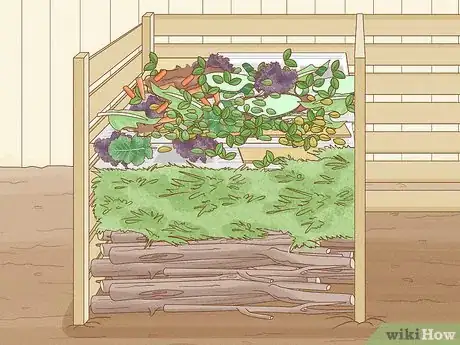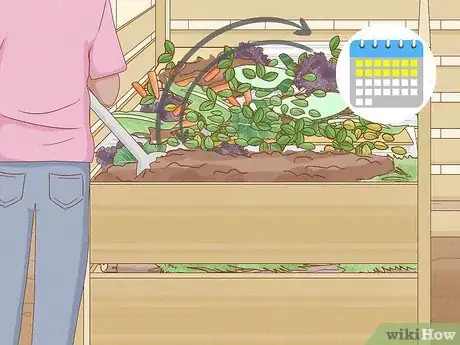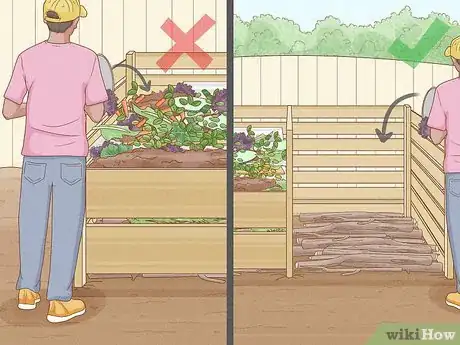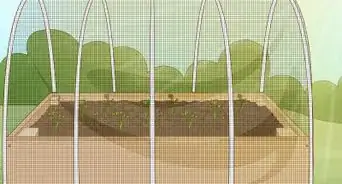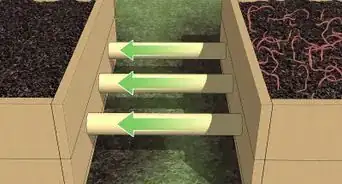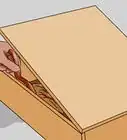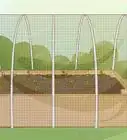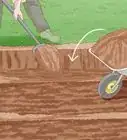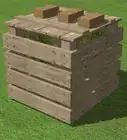This article was co-authored by Artemisia Nursery. Artemisia Nursery is a retail plant nursery in Northeast Los Angeles specializing in California native plants. Artemisia Nursery is a worker-owned small business with plans to become a worker-owned cooperative. In addition to California native plants, Artemisia Nursery offers a selection of succulents, heirloom veggie and herb starts, house plants, pottery, and gardening tools and supplies. Drawing on the knowledge of the founders, Artemisia Nursery also offers consultations, designs, and installations.
This article has been viewed 32,542 times.
Composting is a straightforward process that can be accomplished by anyone with a small patch of outdoor space. Composting allows you to divert your kitchen scraps and yard waste from a landfill, instead of turning them into a rich soil amendment. You only need a few tools, a little bit of time, and some basic information to begin composting and ensure the success of your setup. This guide will help you to create a compost bed (or compost "pile") from scratch and maintain it properly.
Steps
-
1Decide on a location for your compost pile. There are a few considerations to keep in mind when choosing a location. Do not place the compost pile so far from your house that you will be disinclined to add scraps and to monitor its condition. If you have nearby neighbors, they may not appreciate an unsightly compost pile close to their property line. Also, avoid positioning your compost pile on your best garden soil; this robs you of valuable space to grow your vegetables and other plants.
-
2Build an enclosure for your compost pile if desired. A compost bed can be as simple as a large open heap, but an enclosure provides numerous benefits. It keeps rodents and other animals away from your compost, and it helps to keep your compost contained when you turn it with a pitchfork. An enclosure can be made from lumber, poultry wire, concrete blocks, or any manner of fencing.[1] Make sure the enclosure still allows you easy access and is no longer than about 3 feet (1 m) long in any direction.Advertisement
-
3Build a base layer for the compost pile. For efficient decomposition, the microbes in your compost pile need fresh oxygen. The bottom of a compost pile tends to be the most oxygen-starved, as it is farthest from the outside air and gets no ventilation. The best way to remedy this problem is by deliberately building a base layer for your compost pile out of tree branches and limbs. A loose pile of these limbs will help to establish plenty of air pockets in the bottom of the compost pile.
-
4Add your organic scraps to the compost pile. Nearly any plant-based material can be added to a compost bed. Vegetable scraps, coffee grounds and filters, paper, cardboard, and yard clippings are all examples of materials you can add to your compost pile.[2] These materials can be divided into carbon-rich and nitrogen-rich types.
- Nitrogen-rich materials are those that are still in a living state. Fresh leaves, fresh grass clippings, vegetable scraps, and coffee grounds are all nitrogen-rich. These materials should only compose about 1/4 of your pile by volume, or the compost will begin emitting an ammonia-like smell.
- Carbon-rich materials are those that are dead and inert. Paper, cardboard, and sawdust are examples of carbon-rich materials. These items should compose about 3/4 of your compost by volume.[3]
-
5Turn your compost pile occasionally. To continually introduce fresh oxygen into your compost pile, you'll need to mix the materials every 1 or 2 weeks. Use a pitchfork to dig into the pile and fold the compost together. Make sure to dig the materials at the very bottom of the pile up to the top.
-
6Stop adding materials and start a new pile. Eventually, you will need to stop adding fresh organic matter to your compost pile. If you don't, you will eventually have a pile that contains finished compost, freshly added materials, and everything in between. To avoid the difficulty of having to sift out the finished compost, stop adding materials and simply turn your compost regularly until it is finished. Start a new pile to add your fresh scraps to during this process. Your compost will turn into rich, black humus in about a year.
Community Q&A
-
QuestionAre there any vegetable scraps that should not go in the compost?
 HarveyCommunity AnswerIf done correctly and intensively, anything that was once living can go in a compost bed. If you are not an expert, or you have worms in the compost, avoid adding citrus scraps (too acidic for the worms), waxed paper or cardboard (worms cannot digest waxed paper products well), onion scraps (worms do not like onion scraps), and excessive garden waste (worms digest that slowly). Avoid adding meat or bones (they decompose slowly and rodents may forage in the compost) and never place diseased vegetable scraps or vegetative weed material in the compost, because unless you are an expert composter, the heap will not heat up sufficiently to destroy diseases and seeds.
HarveyCommunity AnswerIf done correctly and intensively, anything that was once living can go in a compost bed. If you are not an expert, or you have worms in the compost, avoid adding citrus scraps (too acidic for the worms), waxed paper or cardboard (worms cannot digest waxed paper products well), onion scraps (worms do not like onion scraps), and excessive garden waste (worms digest that slowly). Avoid adding meat or bones (they decompose slowly and rodents may forage in the compost) and never place diseased vegetable scraps or vegetative weed material in the compost, because unless you are an expert composter, the heap will not heat up sufficiently to destroy diseases and seeds.
Warnings
- Never add animal products like meat, bones, and dairy to your compost pile. These materials will turn rancid and attract unwanted pests.⧼thumbs_response⧽
- Never add any animal dung which eats meat either. Cow, horse and chicken are OK, dog and pig are not.⧼thumbs_response⧽
Things You'll Need
- Lumber or poultry wire
- Tree limbs
- Organic materials
- Pitchfork
- Garden hose
References
- ↑ Artemisia Nursery. Plant Nursery & Garden Shop. Expert Interview. 7 August 2020.
- ↑ Artemisia Nursery. Plant Nursery & Garden Shop. Expert Interview. 7 August 2020.
- ↑ Artemisia Nursery. Plant Nursery & Garden Shop. Expert Interview. 7 August 2020.
- http://www.thegardenofoz.org/composting101.asp




